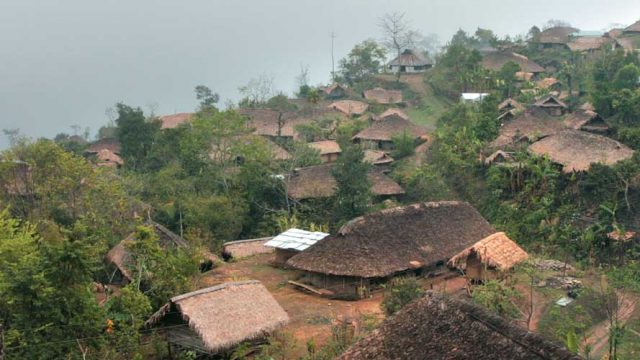Half a day’s drive from Dimapur and a couple of hours’ drive away from Burma, Mon is the stronghold of the proud Konyak tribe, one of the largest tribes of Nagaland. Mon has a cluster of villages, all less than an hour away from each other.
We suggest you time your visit to coincide it with the Aoleong Festival, held in the first week of April. This is when everyone takes out their traditional finery, and even the most urban of the townsfolk sport Konyak necklaces. They wear little shawls, traditional woven hats, and the men are especially conspicuous in their sashes. Hundreds of locals and quite a lot of visitors congregate in the festival grounds, and after the pastor blesses the festival – the region has animists but is still predominantly Christian – men and women from various tribes assemble. And then the dancing, chanting and singing commences.

The men sport hornbill feathers, woven red sashes, knives with furry tails, spears and bells that are attached to their backs, while the women dance more sedately, sporting armbands, belts, waistbands around their shawl-skirts, headbands, earrings and feathers. With their ululating cries and the men’s deeper singing, a powerful unison emerges.
Warriors shoot in the air, creating a thick blanket of smoke. There is soon a mist of smoke from which they are seen only at intervals, their heads lifted in war cry, and guns and spears held aloft in song.

THINGS TO SEE AND DO
In the region around Mon, you will find the last vestiges of the village world that was once Nagaland. You’ll see warriors dressed in all their finery, elderly men with tattoos on their wizened faces, beaded chokers around their necks and little bronze heads that symbolise how many enemy skulls they have claimed.
There are many tribal villages in the area, but the most popular one is Longwa (35km). The headman’s longhouse at Longwa dramatically straddles the India-Myanmar border and contains within it a range of weapons, old totems and other strange historical paraphernalia, making for a visual smorgasbord. The village elders there tend to dress in their traditional costumes, and almost everyone carries the formidable dao – a machete that was originally used for head-hunting and continues to be a standard accessory for the Konyak tribe. Some households augment their income by making and selling tribal jewellery, masks and other local collectibles to tourists.
Twenty-three kilometres from Mon, the village of Shangyu has a small museum housing a fascinating fertility sculpture carved out of wood, while outside is a log drum that was used for sending messages across the hills and is still used during festivals. A couple of tall eerie stones meant to display hunted heads are all that remain of the village’s headhunting past.

Other villages worth visiting include Old Mon (5km) and Singha Chingnyu (20km), the latter with a huge longhouse decorated with animal skulls, stuffed tigers and a storehouse of old human trophies.
WHERE TO STAY AND EAT
Tiny Mon has just two options. Helsa Cottage (Cell: 09862345965; Tariff: ₹1,000–1,500) has an affable host, though the rooms and facilities are basic. Meals are arranged on request.
Outside of town, on the way to Longwa, is Helsa Resort (Cell: 09436000028; Tariff: ₹1,000–1,500), which offers six traditional Konyak huts. It is run by the daughter of the woman at the helm of Helsa Cottage.
FAST FACTS
When to go November to March. Be there in April for the Aoleong festival
Tourist and Permit offices
Nagaland Tourism Office, Kohima, Tel: 0370-2243124,
Resident Commissioner, Nagaland House, 29, APJ Abdul Kalam Road, New DelhiTel: 011-23013751, 23794680, W tourismnagaland.com
Inner Line Permits
These have to be be obtained (carry valid ID) from either address above
STD code 0370
GETTING THERE
State Nagaland
Location The northernmost district of Nagaland, Mon is bounded by Arunachal Pradesh to its north, Assam to its west and Myanmar to its east
Distance 353km NE of Kohima
Route from Kohima Take NH39 till the roundabout on GD Road. Stay on NH37. Take NH702 to Mon
Road Buses and jeeps ply to Mon from Dibrugarh via Sivasagar, and from Mokokchung in Nagaland. But it is best to organise a trip with a tour operator




